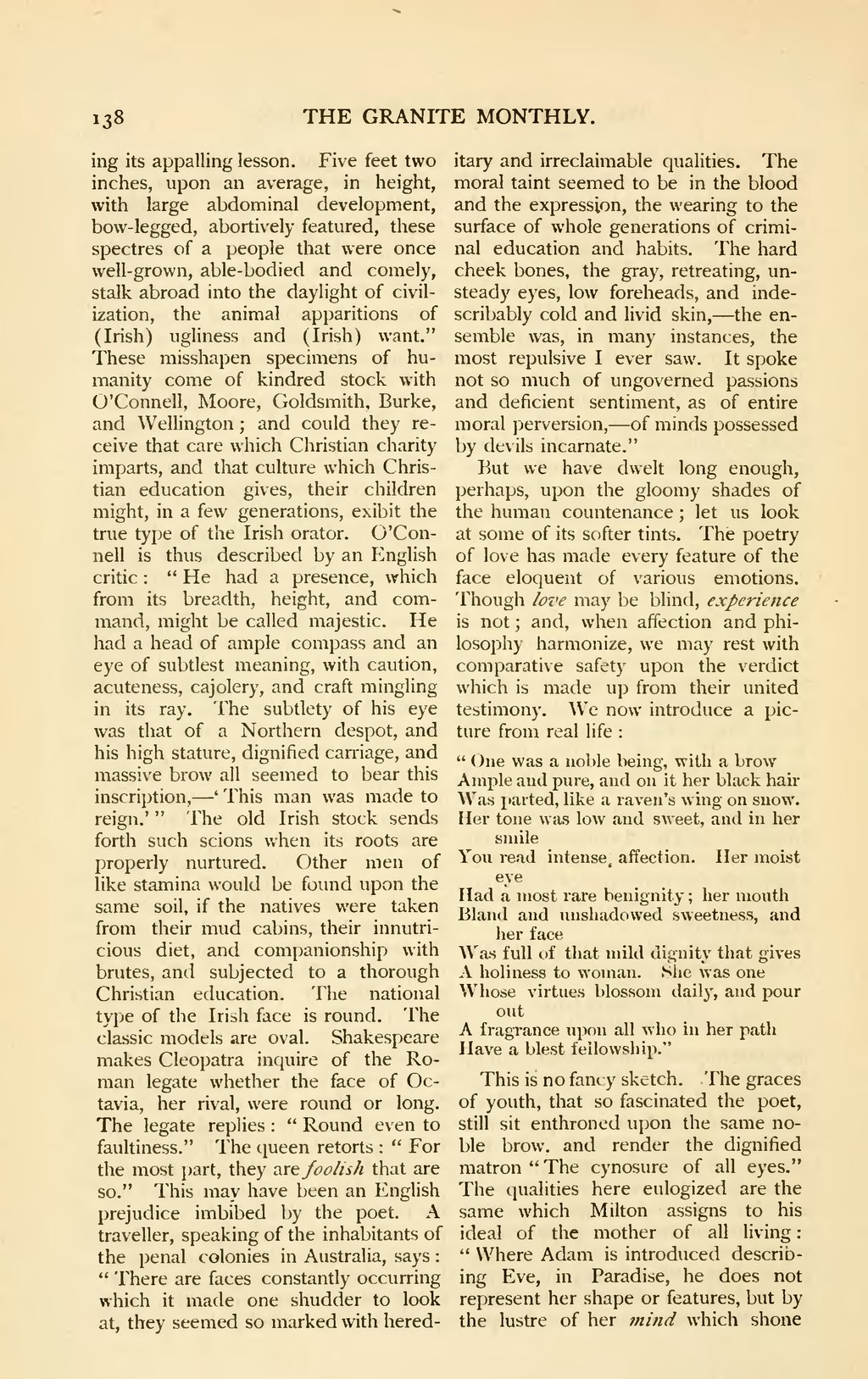ing its appalling lesson. Five feet two inches, upon an average, in height, with large abdominal development, bow-legged, abortively featured, these spectres of a people that were once well-grown, able-bodied and comely, stalk abroad into the daylight of civilization, the animal apparitions of (Irish) ugliness and (Irish) want." These misshapen specimens of humanity come of kindred stock with O'Connell, Moore, Goldsmith, Burke, and Wellington; and could they receive that care which Christian charity imparts, and that culture which Christian education gives, their children might, in a few generations, exibit the true type of the Irish orator. O'Connell is thus described by an English critic: "He had a presence, which from its breadth, height, and command, might be called majestic. He had a head of ample compass and an eye of subtlest meaning, with caution, acuteness, cajolery, and craft mingling in its ray. The subtlety of his eye was that of a Northern despot, and his high stature, dignified carriage, and massive brow all seemed to bear this inscription,—'This man was made to reign.'" The old Irish stock sends forth such scions when its roots are properly nurtured. Other men of like stamina would be found upon the same soil, if the natives were taken from their mud cabins, their innutricious diet, and companionship with brutes, and subjected to a thorough Christian education. The national type of the Irish face is round. The classic models are oval. Shakespeare makes Cleopatra inquire of the Roman legate whether the face of Octavia, her rival, were round or long. The legate replies: "Round even to faultiness." The queen retorts: "For the most part, they are foolish that are so." This may have been an English prejudice imbibed by the poet. A traveller, speaking of the inhabitants of the penal colonies in Australia, says: "There are faces constantly occurring which it made one shudder to look at, they seemed so marked with hereditary and irreclaimable qualities. The moral taint seemed to be in the blood and the expression, the wearing to the surface of whole generations of criminal education and habits. The hard cheek bones, the gray, retreating, unsteady eyes, low foreheads, and indescribably cold and livid skin,—the ensemble was, in many instances, the most repulsive I ever saw. It spoke not so much of ungoverned passions and deficient sentiment, as of entire moral perversion,—of minds possessed by devils incarnate."
But we have dwelt long enough, perhaps, upon the gloomy shades of the human countenance; let us look at some of its softer tints. The poetry of love has made every feature of the face eloquent of various emotions. Though love may be blind, experience is not; and, when affection and philosophy harmonize, we may rest with comparative safety upon the verdict which is made up from their united testimony. We now introduce a picture from real life:
"One was a noble being, with a brow
Ample and pure, and on it her black hair
Was parted, like a raven's wing on snow.
Her tone was low and sweet, and in her smile
You read intense, affection. Her moist eye
Had a most rare benignity; her mouth
Bland and unshadowed sweetness, and her face
Was full of that mild dignity that gives
A holiness to woman. She was one
Whose virtues blossom daily, and pour out
A fragrance upon all who in her path
Have a blest fellowship."
This is no fancy sketch. The graces of youth, that so fascinated the poet, still sit enthroned upon the same noble brow, and render the dignified matron "The cynosure of all eyes." The qualities here eulogized are the same which Milton assigns to his ideal of the mother of all living: "Where Adam is introduced describing Eve, in Paradise, he does not represent her shape or features, but by the lustre of her mind which shone
